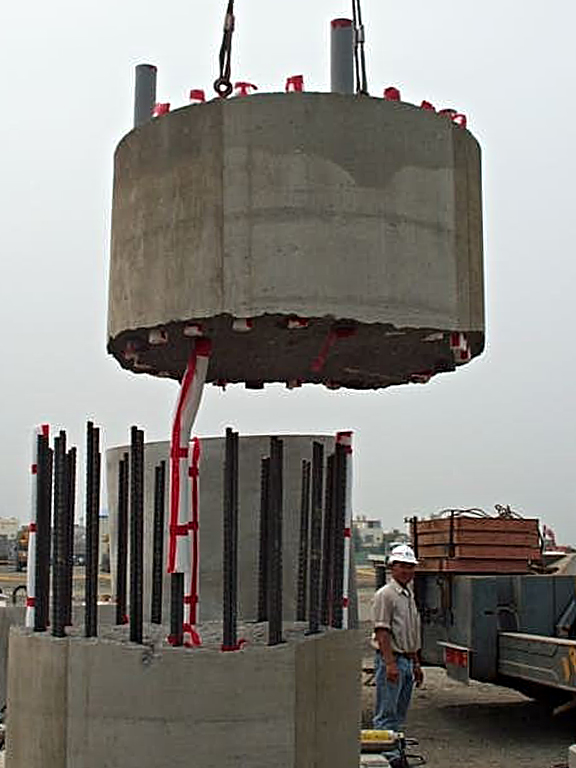When cutting reinforced concrete pillars, difficulties often arise regarding the tools and the method used to work efficiently and quickly. The reason for this is their time-honored construction method. The steel reinforcement is usually located at the edge of the concrete pillar, and its size and load-bearing capacity determine its diameter. Probably, the requirements of later demolition are never thought of when the piers are made.
A variety of methods are used for demolition of reinforced concrete piers – which usually have a reinforcement of 32 mm diameter in the edge area of the round pier. Rock and Concrete Splitters have so far proven to be the best solution for demolition of piers. They are powerful -even under water- and work silently with low vibration.
Compared to conventional methods, the Darda splitting unit offers significant advantages:
(a) No vibration: the application is noiseless and free from vibration. The strength and rigidity of the pillar are not affected.
(b) Precision: The pillar can be split exactly at the desired point.
(c) Very fast: Compared to days required by conventional methods, the Darda splitter takes only a few minutes to smoothly split a pier.
(d) Economical: The most cost effective method due to its quick execution.
(e) Safe: No flying debris as with other methods.
(f) Safe: No flying debris as with other methods.
By taking into account the demolition that will be required at a later date during pier fabrication, the effort required to do so can be greatly reduced and simplified.
The procedure explained below takes these requirements into account and is widely used in most countries.
The following method of construction is suggested for reinforced concrete piers:
(a) The insertion of a PVC strip or other bond breaker around the reinforcement along its entire length, and staggering the steel bars to the perimeter of the reinforced concrete pier.
(b) The insertion of a 44-46 mm diameter rigid PVC pipe across the diameter of the pier (ID), directly at the bottom of the pier section to be removed. The wall thickness of the pipe should be approximately 5 mm.
(c) The insertion of a lifting eye of sufficient size and strength at the head and center of the pier to facilitate lifting by crane.
The proposed construction method for the pier allows for easy demolition using a Rock and Concrete Splitter. This method greatly simplifies the demolition of piers.
Demolition is accomplished in the following steps:
(a) If the pier is to be demolished, splitting equipment is used at both ends of the thin steel tube (embedded in the bottom of the pier, across the diameter of the pier section at the time of fabrication).
(b) Operate both splitting devices simultaneously to produce a clean split across the entire cross section of the pier.
(c) Attach the hook of a crane of sufficient capacity to the lifting eye at the head of the pier.
(d) Once a gap has formed in the pier around its entire circumference and it separates from the lower portion (due to the PVC strip around the reinforcing bars), the concrete will separate from the steel bars and the pier can be cleanly separated from its base and disposed of at the dump site.
(e) The steel reinforcement can be cut out later with a welder.
 whdrill 34mm 36mm 38mm 40mm 42mm taper drill bits for jack hammer
whdrill 34mm 36mm 38mm 40mm 42mm taper drill bits for jack hammer
 R32 43mm 45mm 51mm Hard Rock Thread Drill Bits
R32 43mm 45mm 51mm Hard Rock Thread Drill Bits
 Atlas Copco 32-42mm Taper Button Rock Drill Bits
Atlas Copco 32-42mm Taper Button Rock Drill Bits
 Diaroc Grinding Pin for DTH Hammer Bits
Diaroc Grinding Pin for DTH Hammer Bits